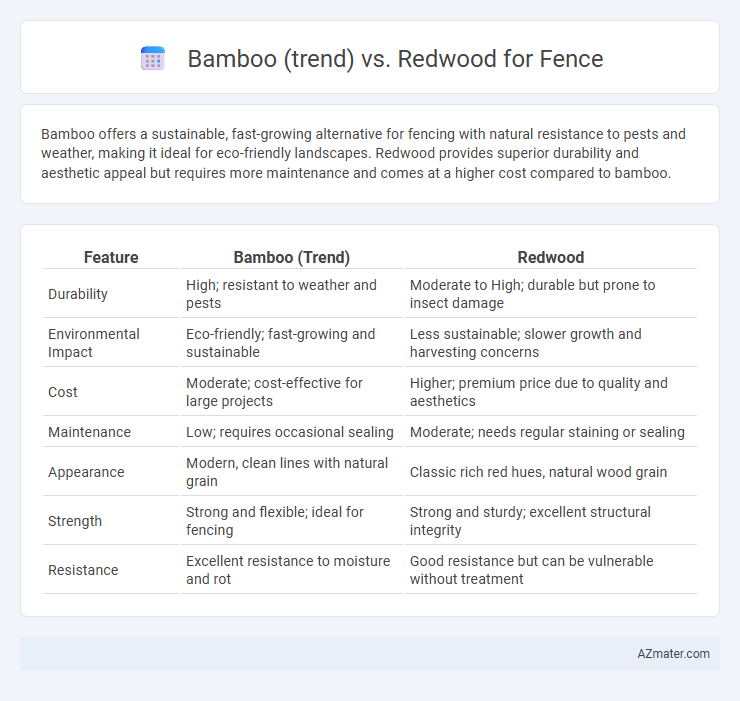Bamboo offers a sustainable, fast-growing alternative for fencing with natural resistance to pests and weather, making it ideal for eco-friendly landscapes. Redwood provides superior durability and aesthetic appeal but requires more maintenance and comes at a higher cost compared to bamboo.
Table of Comparison
| Feature | Bamboo (Trend) | Redwood |
|---|---|---|
| Durability | High; resistant to weather and pests | Moderate to High; durable but prone to insect damage |
| Environmental Impact | Eco-friendly; fast-growing and sustainable | Less sustainable; slower growth and harvesting concerns |
| Cost | Moderate; cost-effective for large projects | Higher; premium price due to quality and aesthetics |
| Maintenance | Low; requires occasional sealing | Moderate; needs regular staining or sealing |
| Appearance | Modern, clean lines with natural grain | Classic rich red hues, natural wood grain |
| Strength | Strong and flexible; ideal for fencing | Strong and sturdy; excellent structural integrity |
| Resistance | Excellent resistance to moisture and rot | Good resistance but can be vulnerable without treatment |
Introduction: Comparing Bamboo and Redwood Fencing Trends
Bamboo fencing offers a sustainable, fast-growing alternative with natural resistance to pests and moisture, making it an eco-friendly choice for modern landscapes. Redwood fencing provides durability, rich color, and natural weather resistance due to its dense grain and high tannin content, favored in traditional and upscale installations. Both materials reflect evolving trends towards combining aesthetic appeal with environmental responsibility in outdoor design.
Sustainability: Bamboo vs Redwood Environmental Impact
Bamboo fences exhibit remarkable sustainability due to their rapid growth rate, with bamboo reaching maturity in 3-5 years, significantly reducing environmental impact compared to redwood, which typically takes 50-60 years to mature. Bamboo's ability to regenerate without replanting minimizes soil disruption and carbon footprint, whereas redwood harvesting can contribute to deforestation and habitat loss despite its durability and natural resistance to decay. Sustainable bamboo sourcing and certification further enhance its eco-friendly profile, making it a preferred choice for environmentally conscious fencing solutions.
Durability and Longevity of Bamboo and Redwood Fences
Bamboo fences offer impressive durability due to their natural resistance to moisture, pests, and rot, often lasting up to 15-20 years with proper treatment. Redwood fences, prized for their dense grain and high tannin content, provide long-lasting strength and can endure 20-30 years under favorable conditions. Both materials require regular maintenance, but redwood's superior weather resistance generally ensures greater longevity compared to bamboo in harsh climates.
Cost Comparison: Bamboo vs Redwood Fencing
Bamboo fencing typically costs between $15 to $25 per square foot, making it a more affordable and sustainable choice compared to redwood, which ranges from $25 to $40 per square foot due to its durability and premium quality. Bamboo requires less maintenance, reducing long-term expenses, while redwood's higher cost reflects its resistance to decay and insect damage. Homeowners seeking budget-friendly and eco-friendly fencing often prefer bamboo, whereas those prioritizing longevity and aesthetic appeal might invest in redwood despite the higher initial price.
Maintenance Requirements for Bamboo and Redwood
Bamboo fences require regular cleaning and sealing to prevent mold, mildew, and cracking due to their natural moisture absorption, while redwood fences demand annual staining or sealing to maintain resistance against rot and insect damage. Bamboo's maintenance involves ensuring proper drainage and avoiding direct ground contact to extend longevity, contrasting with redwood's tolerance for soil contact but need for consistent UV protection. Both materials benefit from routine inspections, but bamboo's rapid growth and porous nature necessitate more frequent care compared to the denser, naturally resistant redwood.
Aesthetic Appeal: Visual Differences Between Bamboo and Redwood
Bamboo fences showcase a sleek, natural texture with vertical, uniform stalks that create a modern, minimalist aesthetic. Redwood offers rich, reddish hues with varied grain patterns and knots, providing a classic, rustic charm. The choice between bamboo's smooth, contemporary look and redwood's warm, traditional appeal depends on the desired design and atmosphere of the outdoor space.
Installation Ease: Bamboo vs Redwood Fence Construction
Bamboo fences offer quicker installation due to their lightweight, flexible stalks and simple panel systems, making them ideal for DIY projects and uneven terrain. Redwood fencing requires more precise measurements, heavier material handling, and professional tools to ensure durability and proper alignment. Bamboo's modular design reduces labor time, while redwood often demands skilled carpentry for secure post setting and board attachment.
Versatility and Customization Options
Bamboo fences offer exceptional versatility with their natural flexibility, allowing various panel styles such as rolled, woven, or vertical slats that suit both contemporary and tropical aesthetics. Redwood fences provide strong customization options through stain and paint choices, as well as designs ranging from classic picket to intricate lattice work, making them ideal for homeowners seeking traditional or rustic charm. Bamboo's rapid growth and eco-friendliness contrast with redwood's durability and resistance to insects, influencing fence longevity and maintenance preferences.
Resistance to Pests and Weather Conditions
Bamboo fences exhibit exceptional resistance to pests such as termites and ants due to their natural silica content, making them durable in various weather conditions including humidity and rain. Redwood offers strong resistance to decay and insects from its high tannin levels, which protect it against moisture and fungal attacks, enhancing its longevity in outdoor environments. Both materials provide robust protection, but bamboo's rapid growth and natural pest-repellent properties often give it an ecological and durability advantage in tropical and subtropical climates.
Which Fence to Choose: Bamboo or Redwood?
Bamboo fences offer eco-friendly sustainability, rapid growth, and a modern aesthetic with high resistance to moisture and pests, making them ideal for tropical climates. Redwood fences provide natural durability, rich color, and excellent resistance to rot and insects, suited for traditional, long-lasting outdoor privacy. Choose bamboo for a cost-effective, renewable option or redwood for premium quality and timeless appeal in fencing solutions.

Infographic: Bamboo (trend) vs Redwood for Fence
 azmater.com
azmater.com